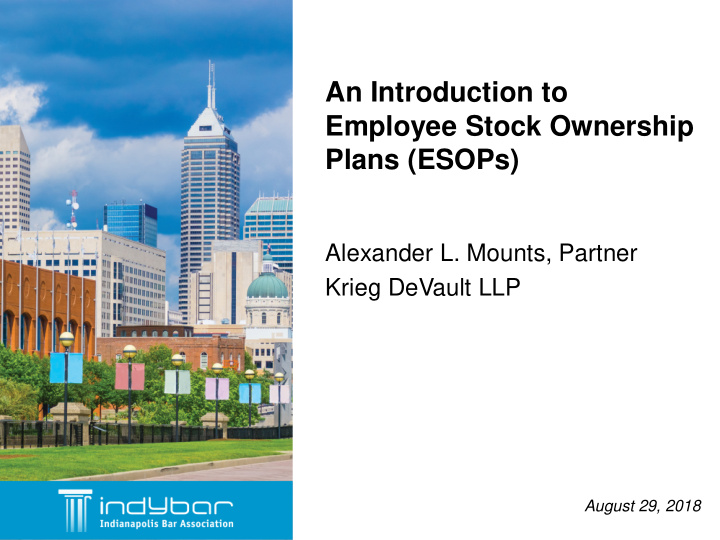



An Introduction to Employee Stock Ownership Plans (ESOPs) Alexander L. Mounts, Partner Krieg DeVault LLP August 29, 2018
What is an “Employee Stock Ownership Plan”? • Tool of CORPORATE FINANCE/SUCCESSION VEHICLE • Tax-qualified RETIREMENT PLAN • Invests “primarily” in EMPLOYER STOCK • Numerous Federal tax incentives encourage implementation 2
ESOPs in the U.S. • Common transition strategy: • Alternative to selling to an outsider • Gradual Common transition strategy: • Tax benefits *6,669 ESOPs • Alternative to selling to an outsider 14 million employees • Gradual $1.3 trillion in plan assets • Tax benefits *March 2018 National Center for Employee Ownership (www.nceo.org) 3
National ESOPs 4
Indiana ESOPs 5
Good ESOP Candidates • Closely held U.S. based company • Company can be a C-corp or an S-corp • At least 20 employees (companies with small payroll bases may encounter problems under Code Sections 415 and 409(p)) • Profitable • Debt capacity • Stable earnings • Supportive management 6
Good ESOP Candidates • Identified ESOP objectives – Create and realize employee retirement benefits, cultural improvements, and operational efficiencies – Protect the shareholders’ legacy and Company heritage while realizing liquidity – Company desiring to utilize corporate tax savings to increase growth and accelerate debt repayment – Reward employees and management who helped build the Company 7
Advantages ESOPs Flexibility • Market for shareholders’ stock • Unlike most buyers, serves as source of funds to purchase minority blocks • Low marketability discount (typically 5%) on value of shares • Succession planning vehicle for gradual transfer of ownership to next generation (often combined with transfers of ownership to management – “sweat equity”) • “Financial” buyer with long term perspective • Easily combined with “401(k)” plan – use of “matching” contributions to fund ESOP; some transactions allow employees to transfer 401(k) funds to ESOP 8
Advantages of ESOPs Tax • ESOP’s share of company’s income is not subject to tax • Contributions to ESOP are tax deductible (important if ESOP owns less than 100%) • ESOP’s share of “tax dividends” can be used to repay loan, satisfy repurchase liability or pay expenses • Allocations to participants’ accounts are tax deferred; distributions are eligible for tax-free rollover • Special tax treatment of “net unrealized appreciation” on distribution of stock 9
Effect on Employees (Well Communicated ESOPs) • Pride of ownership culture • Recruiting/retention tool • Increased commitment and enthusiasm • Material increase in value of corporation* *See Key Studies on Employee Ownership and Corporate Performance at https://www.nceo.org/articles/studies-employee-ownership-corporate-performance 10
Disadvantages of an ESOP • Cost and number of service providers • Complexity • Communication • Repurchase liability • Less diversification of retirement assets • Fiduciary responsibility/liability 11
ESOP Valuation Considerations • ESOP Valuation vs. “Multiple of Book” – How should ESOP shares be valued? – Independent appraisal firm qualified and experienced with ESOP valuations – Appropriate methods of valuing companies – Weighting of methods – Use of publicly available information regarding non-publicly traded companies • Financial performance • Merger and acquisition activity – Effect of cash and stock dividends on value – Effect of repurchase obligation on value 12
Basic Structure of an ESOP Transaction (Bank Financing) Step 1 1. Bank Loan Employer Bank 2. Pledge of Collateral 4. Cash/Note Shareholders ESOP 5. Employer Stock 13
Basic Structure of an ESOP Transaction Step 2 3. Loan Payments Bank Employer 1. Contributions Dividends Stock Seller ESOP 14
Examples of Benefits of “S” Corporation ESOP Structure Net Income of $5,000,000 Net Income of $5,000,000 Net Income of $5,000,000 with No ESOP with 50% ESOP with 100% ESOP Corporate Tax -0- Corporate Tax -0- Corporate Tax -0- Individual Shareholder Tax: Individual Shareholder Tax: on $5,000,000 @ 45% = $2,225,000 on $2,500,000 @ 45% = $1,125,000 ESOP Shareholder Tax on $2,500,000 = $0 ESOP Shareholder Tax on $5,000,000 = $0 Total “Tax Dividends” = $2,225,000 Total Tax Dividends = $2,225,000 Additional cash flow = $2,225,000 ESOP’s Share = $1,125,000 15
ESOP “Myths” • ESOP Trustee will become involved in running the company • Employees or trustee must have seat on Board • Management structure will change; the ESOP will become involved in management • Stock valuation, compensation and/or corporation’s financial statements must be disclosed • Corporation will be less attractive to potential buyers • Corporation cannot “go public” later 16
Characteristics of Well-Designed and Implemented ESOPs • “Sanity check” approach to implementation a. Stock valuation b. Feasibility c. Financing d. Commitment of key managers • Independent, experienced advisors to ESOP a. Counsel b. Financial Advisor c. Trustee • Well-educated ESOP “Committee” • Well-prepared feasibility analysis a. Projections based on history b. “Cushion” for economic downturn • Repurchase Liability Study 17
Disclaimers • These slides are for educational purposes only and are not intended, and should not be relied upon, as legal or accounting advice. • Pursuant to Circular 230 promulgated by the Internal Revenue Service, please be advised that these slides were not intended or written to be used, and that they cannot be used, for the purposes of avoiding federal tax penalties unless otherwise expressly indicated. 7524044.1 18
Speaker Contact Information Alexander L. Mounts, Partner Krieg DeVault LLP One Indiana Square, Ste. 2800 Indianapolis, IN 46204 E: amounts@kdlegal.com P: 317-238-6335
Stay connected and visit us online!
Recommend
More recommend